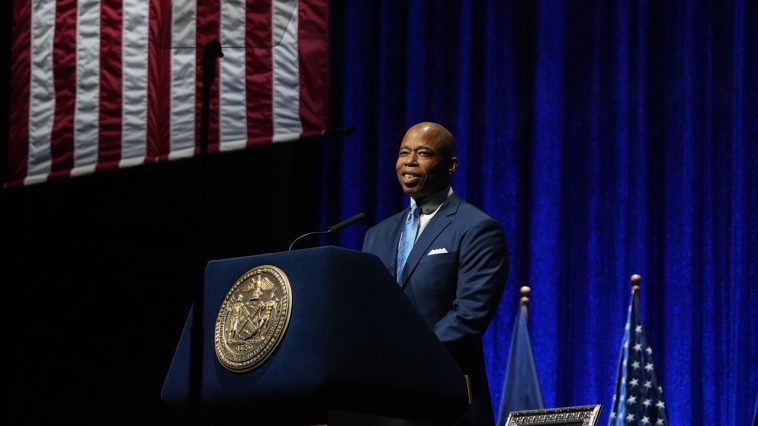The largest public school system in the United States is taking a new approach to teaching children to read, as New York City’s School Chancellor declares that the previous methods have failed their students. On Tuesday, a new literacy program was introduced at PS 156 in Brownsville to address the significant decline in reading scores and the lingering concerns over students struggling to catch up after COVID-related disruptions. Mayor Eric Adams, who is dyslexic, emphasized the importance of education for the betterment of society: “If you don’t educate, you incarcerate.” He explained that there is a noticeable pattern linking education and criminal behavior among young people.
The current literacy program in New York City schools has been criticized for leaving far too many children behind. NYC Schools Chancellor David Banks stated, “There’s one thing I’ve learned more than anything else: Too many of our children do not know how to read.” As a response to this issue, new lesson plans will shift their focus to phonics, teaching children how to sound out words, in contrast to the existing methods which emphasize visuals.
The city’s thirty-two school districts will have the autonomy to select one of three phonics-based programs, using their superintendent’s discretion for implementation. Beginning in September, half of the districts will adopt this new literacy program while the remaining schools are expected to follow suit in 2024. Presently, around 50% of public school students in grades 3-8 are classified as “not proficient in reading,” with these concerning statistics often affecting low-income and minority students to a greater extent.
United Federation of Teachers President Michael Mulgrew praised the phonics-based approach, asserting, “The only way to do this en masse is to have a sound, really good literacy curriculum in place which is phonetically-based.” However, not everyone is in agreement with the new plan. The principals union, led by Henry Rubio, president of the Council of School Supervisors and Administrators, expressed their discord on the matter.
Rubio released a statement saying that his organization does not concur with the idea of “mandating a single curriculum across a given school district” to achieve this critical goal. Many principals and school leaders feel as though the city’s Department of Education has not provided them with adequate opportunities to engage their communities during the initiation of this new literacy initiative.
In addition to the changes being made to reading instruction, there are also plans to alter the way algebra is taught in schools. This transformation, along with the new literacy program, is part of a broader effort to create a more centralized and consistent curriculum, tackling city-wide concerns?
The issue of literacy rates in New York City is a profoundly complex one, with the impacts extending beyond the classroom and into society at large. As Mayor Adams pointed out, low literacy rates can correlate with increased criminal behavior, making this issue a priority for the city’s administration.
By focusing on phonics and implementing a more structured curriculum, New York City hopes to see an improvement in overall reading proficiency among its students. The ultimate goal is to ensure that the children in the city’s public schools not only become capable readers but also lead successful and fulfilling lives beyond their educational journey.
Critics of the current literacy program argue that it has largely failed students in need, as evidenced by disproportionately low reading scores for low-income and minority populations. With the introduction of a new phonics-based approach, the hope is to address these inequalities at their root, giving children from all backgrounds the opportunity to excel.
The contrasts between the United Federation of Teachers and the Council of School Supervisors and Administrators highlight the complexities and challenges surrounding the implementation of a new curriculum. While a phonics-based approach may seem like a promising alternative, it is evident that many educators feel it should not be a one-size-fits-all solution.
Despite the resistance from some members of the educational community, the NYC administration is determined to move forward with the new literacy plan as a priority for the city’s future. As students continue to navigate post-COVID learning, it is essential for the city to adapt its educational strategies to best serve its diverse population.
The proposed changes to the city’s math curriculum, alongside the new literacy program, reflect a significant shift in educational approach. By creating a more consistent curriculum and tackling city-wide concerns, New York City aims to ensure that its young residents receive the quality education that they deserve.
While it remains to be seen exactly how these educational adjustments will play out in New York City public schools, the push for change is an important indicator of the administration’s commitment to addressing literacy rates and closing the educational gap for its diverse student population.
As with any major educational reform, this new phonics-based literacy program will likely face its share of challenges, both in terms of implementation and pushback from various stakeholders. However, the city’s commitment to improving education for its students and addressing inequalities within the system is an important and commendable step forward.
Ultimately, the success of the new curriculum will be determined by the impact it has on the lives of the children it aims to serve. For New York City public school students, their future success hinges on the ability to achieve and sustain better literacy rates, and this new approach may be a key factor in realizing that goal.


